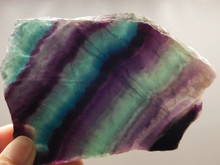For many rock collectors it is not about beauty, or rarity, or location.
Fluorescence is about how that rock or mineral looks under a UV light.
Some ordinary and often ugly rocks actually glow (or appear to emit their own light) in beautiful fluorescent colors, such as purple, pink, green, blue and red.
Most minerals fluoresce in one color, but some rocks that contain more than one mineral may glow in multi colors. This phenomenon is known as fluorescence.
Approximately 15% of all rocks fluoresce. The rocks absorb a small amount of the UV light, transform it into energy and release it in a different wavelength visible to the human eye. If you haven’t witnessed this phenomenon you should. If you go to rock and mineral shows, most likely you have seen the exhibits set up with dark drapes, and surrounded by kids and adults alike, oohing and ahhing. Some museums and universities also have displays.
The term fluorescence was created by G. G. Stokes in 1852. He combined the word “fluorite” one of the first minerals observed fluorescing, and “opalescence”, a word used to describe the changing color effect of opals.
UV light, or Ultra Violet light, has shorter wavelengths than visible light. It was discovered in 1801 by John Ritter, who conducted an experiment to investigate the existence of energy beyond the violet end of the visible spectrum. For many years the study of fluorescence was limited to laboratories because of the need for large special lights and power supplies. However in recent years the technology has improved so much that now you can find UV flashlights.
The interest in fluorescing rocks was first developed to enhance prospecting and mining. Tungsten and uranium are associated with many valuable minerals, so UV lights were used to find sources of these minerals. Of course natural curiosity lead people to wonder what other minerals would fluoresce. In the 1960’s the idea of collecting fluorescent rocks became popular. Even today, the study of fluorescing rocks provides discoveries in such fields as biotechnology, medicine, mineralogy, and security.
Fluorescence is not usually used in mineral identification. Most minerals are not fluorescent and the property is unpredictable. Calcite provides a good example. Some calcite does not fluoresce. Specimens of calcite that do fluoresce glow in a variety of colors including: red, blue, white, pink, green and orange. Fluorite typically fluoresces a violet-blue, but not all fluorite fluoresces, and some fluoresces a white. The difference is attributed to impurities present in the mineral.
In 1971 the Fluorescent Mineral Society (FMS) was established. Here people could get together to share observations, and pictures with like-minded collectors. It is now an international organization, with a worldwide membership of about 400 people.
In the 1980’s Dr. Gerhard Henkel compiled a list of fluorescent minerals. By his death in 1990 he had compiled a list of 566 mineral species and 59 related substances.
Here at Oakrocks we do not specifically carry fluorescent minerals, as it is a small niche market. However we do carry some minerals that are known to fluoresce! We have not actually tested them to verify they do and make no claims as to their doing so. We do know our Ruby in our Ruby and Fuchsite fluoresces as a customer tested it and buys it for that reason.
We also carry Fluorite, Calcite, Selenite, Celestite, and Sodalite. Click on the name to see what we have available.
And we may even hjave others that I’m not aware of!
Happy Hunting!
 US Dollar
US Dollar
 Australian Dollar
Australian Dollar
 Euro
Euro
 CAD
CAD

